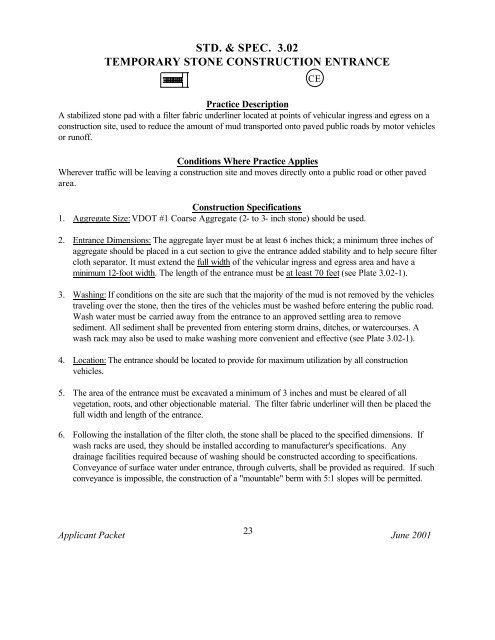APPLICANT PACKET - Virginia Department of Conservation and ...
APPLICANT PACKET - Virginia Department of Conservation and ...
APPLICANT PACKET - Virginia Department of Conservation and ...
You also want an ePaper? Increase the reach of your titles
YUMPU automatically turns print PDFs into web optimized ePapers that Google loves.
STD. & SPEC. 3.02<br />
TEMPORARY STONE CONSTRUCTION ENTRANCE<br />
Practice Description<br />
A stabilized stone pad with a filter fabric underliner located at points <strong>of</strong> vehicular ingress <strong>and</strong> egress on a<br />
construction site, used to reduce the amount <strong>of</strong> mud transported onto paved public roads by motor vehicles<br />
or run<strong>of</strong>f.<br />
Conditions Where Practice Applies<br />
Wherever traffic will be leaving a construction site <strong>and</strong> moves directly onto a public road or other paved<br />
area.<br />
Construction Specifications<br />
1. Aggregate Size: VDOT #1 Coarse Aggregate (2- to 3- inch stone) should be used.<br />
2. Entrance Dimensions: The aggregate layer must be at least 6 inches thick; a minimum three inches <strong>of</strong><br />
aggregate should be placed in a cut section to give the entrance added stability <strong>and</strong> to help secure filter<br />
cloth separator. It must extend the full width <strong>of</strong> the vehicular ingress <strong>and</strong> egress area <strong>and</strong> have a<br />
minimum 12-foot width. The length <strong>of</strong> the entrance must be at least 70 feet (see Plate 3.02-1).<br />
3. Washing: If conditions on the site are such that the majority <strong>of</strong> the mud is not removed by the vehicles<br />
traveling over the stone, then the tires <strong>of</strong> the vehicles must be washed before entering the public road.<br />
Wash water must be carried away from the entrance to an approved settling area to remove<br />
sediment. All sediment shall be prevented from entering storm drains, ditches, or watercourses. A<br />
wash rack may also be used to make washing more convenient <strong>and</strong> effective (see Plate 3.02-1).<br />
4. Location: The entrance should be located to provide for maximum utilization by all construction<br />
vehicles.<br />
5. The area <strong>of</strong> the entrance must be excavated a minimum <strong>of</strong> 3 inches <strong>and</strong> must be cleared <strong>of</strong> all<br />
vegetation, roots, <strong>and</strong> other objectionable material. The filter fabric underliner will then be placed the<br />
full width <strong>and</strong> length <strong>of</strong> the entrance.<br />
6. Following the installation <strong>of</strong> the filter cloth, the stone shall be placed to the specified dimensions. If<br />
wash racks are used, they should be installed according to manufacturer's specifications. Any<br />
drainage facilities required because <strong>of</strong> washing should be constructed according to specifications.<br />
Conveyance <strong>of</strong> surface water under entrance, through culverts, shall be provided as required. If such<br />
conveyance is impossible, the construction <strong>of</strong> a "mountable" berm with 5:1 slopes will be permitted.<br />
Applicant Packet<br />
23<br />
June 2001<br />
CE
















